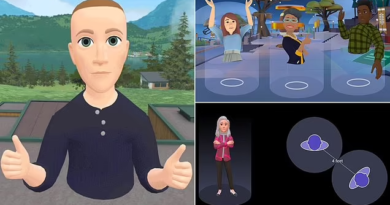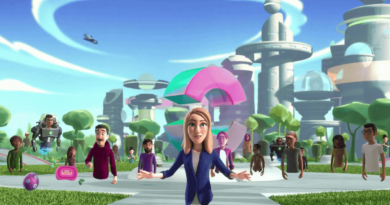Seven Layers In Metaverse
Over the last two years, metaverse technologies have matured due to investments from firms like Meta Platforms, Microsoft, Epic Games, and many others. Metaverse is going to be a revenue-generating opportunity among investors. So, there is a need to understand this fictional universe down to the main building blocks of its architecture.
Over the last two years, metaverse technologies have matured due to investments from firms like Meta Platforms, Microsoft, Epic Games, and many others. Metaverse is going to be a revenue-generating opportunity among investors. So, there is a need to understand this fictional universe down to the main building blocks of its architecture.
According to the famous author and entrepreneur Jon Radoff, who has extensively written on Web3 and related topics, the Metaverse consists of seven core layers. These seven layers represent various phases of the value chain of the metaverse market.
It is a simple systematic approach to describe the framework of the Metaverse. This article provides each of these seven layers to deepen your understanding of the Metaverse and help you tap into its true potential.
What Are The Seven Layers In Metaverse?
The seven layers in the Metaverse are listed below:
- The experience layer
- The discovery layer
- The creator economy
- The spatial computing layer
- The decentralization layer
- The human interface layer
- The infrastructure layer
More Details on The Seven Layers in Metaverse
Let’s dig deep into the seven layers of the Metaverse for a better understanding!
1. The Experience Layer
The Metaverse concept is not limited to a passively visual 3D representation of the physical universe. Instead, it will involve digital twinning to depict spatial coordinates and distances accurately.
The Metaverse consists entirely of experiences and excitement. The resources it has generated directly result from the realistic experiences it is positioned to offer. A metaverse’s immersive and real-time aspects may revolutionize various human activities, including gaming, social interactions, eCommerce, entertainment, and e-sports.
2. The Discovery Layer
The majority of discovery platforms may be categorized as either inbound or outbound. The discovery layer describes how consumers discover new experiences or platforms through app stores, search engines, review sites, and display advertising. It is an important phase in finding new technologies, protocols, and communities.
3. The Creator Economy
The creator economy refers to many design tools and applications developers and content creators use to produce digital resources, immersive experiences, and other assets. Over time, many platforms have included drag-and-drop capabilities to simplify the authoring process.
It has never been simpler to become a creator, developer, or designer, and it will only get easier as Web3 becomes more ingrained in the culture and Web2 is phased away over time. It is seen on several Metaverse platforms, such as The Sandbox, that make the production of digital assets exceedingly simple and code-free.
4. The Spatial Computing Layer
Spatial computing refers to a technology solution that merges virtual and augmented reality (VR/AR) to provide a high level of authenticity. Spatial computing enables users to control and explore 3D places and digitize items utilizing the cloud and surrounding physical worlds using spatial mapping, which visualizes data linked to physical spaces in user environments, according to Radoff.
5. The Decentralization Layer
The Metaverse would be decentralized, open, distributed, and managed by a decentralized autonomous organization (DAO) with open ownership. Central ownership would only be possible for regular users to determine who was privy to it and under what circumstances. It could result in security breaches, which would upset the users.
Blockchain technology is a breakthrough for resolving privacy and data security problems that might affect a centralized metaverse. Several blockchain-based apps, also known as decentralized apps (dApps), are being developed. They are used throughout sectors and leverage the blockchain’s inherent security and decentralization.
The most well-known example of the decentralized Metaverse is Decentraland. This decentralized virtual world runs on the Ethereum blockchain and is governed by a DAO whose policies may be altered by voting.
6. The Human Interface Layer
The human interface layer describes the technologies that let users explore the Metaverse through sophisticated human-computer interaction (HCI). It comprises VR headsets, smart glasses, and haptic technologies where users can navigate digital worlds.
It will also allow users to acquire information about their environment using technologies like Google Glass or Meta Platform’s Project Aria.
7. The Infrastructure Layer
The seventh layer consists of technologies that make previous ideas a reality. It requires a 5G capable infrastructure to increase network capacity and decrease network congestion and latency.
Additionally, for the devices indicated in the human interference layer to function appropriately, devices need components like semiconductors, microelectromechanical systems (MEMS), and tiny, long-lasting batteries. Wi-Fi, the blockchain, artificial intelligence (AI), cloud architecture, and graphics processing units empower the Metaverse.
Conclusion
With big tech firms like Google, Apple, Facebook, NVIDIA, HTC VIVE, and Microsoft heavily investing in the Metaverse, it has become a prominent subject of discussion among investors, technology enthusiasts, and end-users.
Everyone wants to explore the origin of Metaverse, its location, and its possibilities. Understanding the seven levels that comprise the Metaverse is an excellent way to try and comprehend its vast potential, with each layer representing an essential feature functioning collaboratively with the other six levels.



